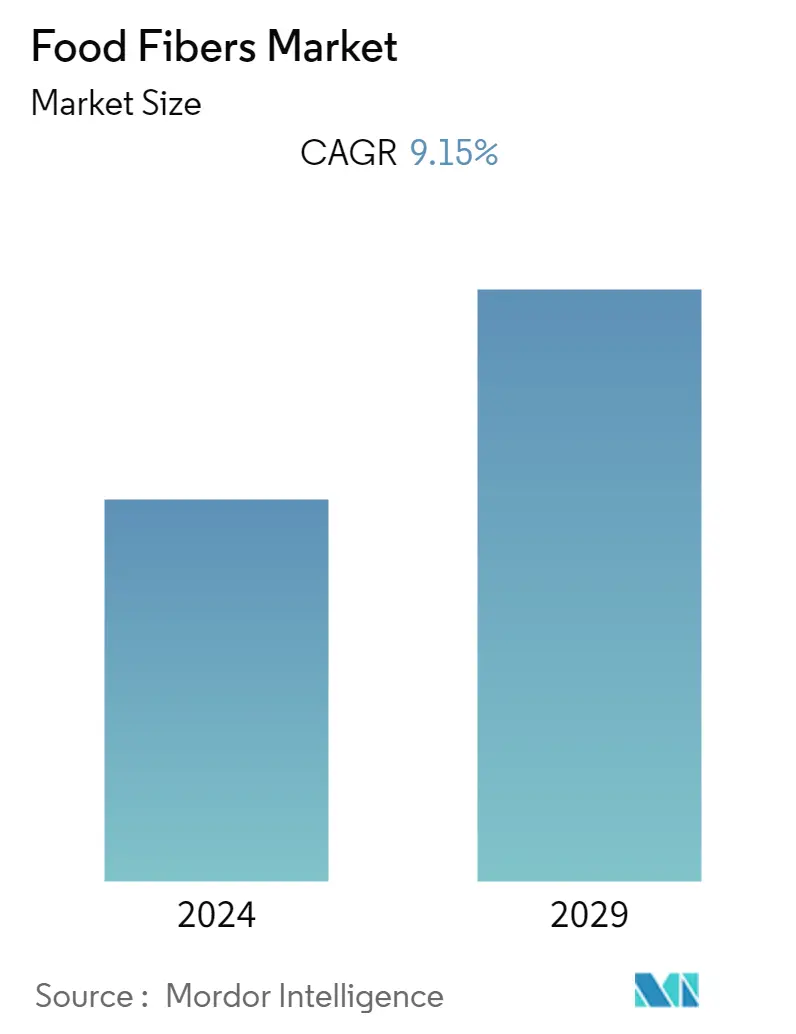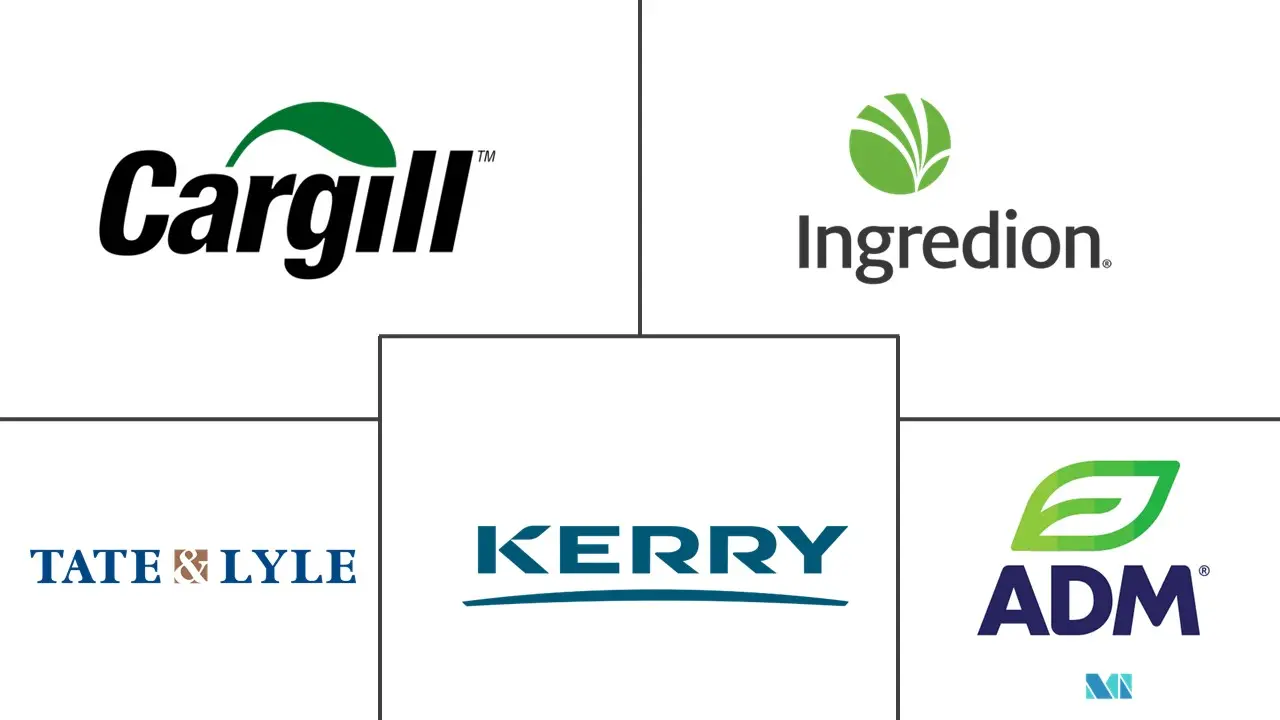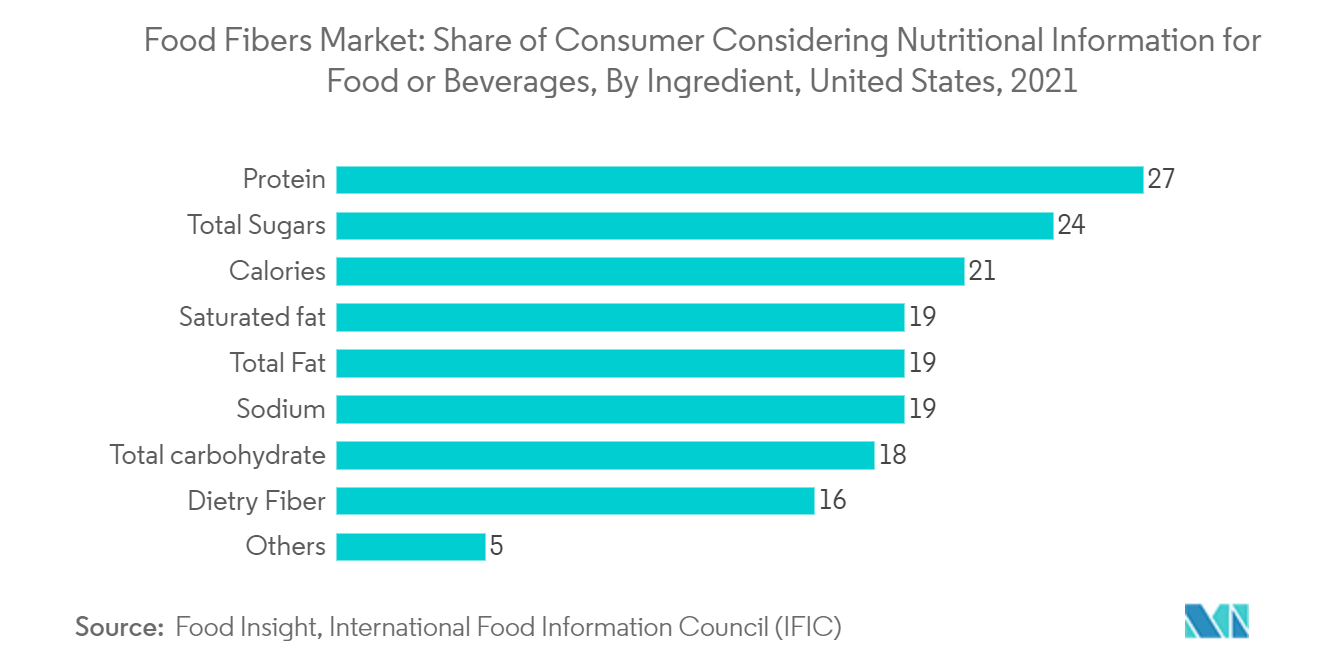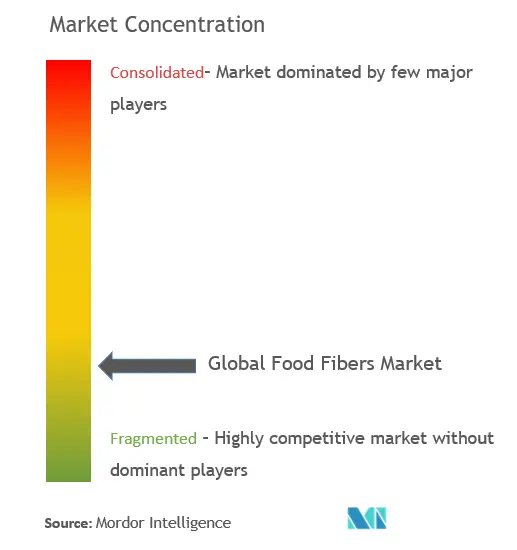Food Fibers Market Size

| Study Period | 2018 - 2029 |
| Base Year For Estimation | 2023 |
| CAGR | 9.15 % |
| Fastest Growing Market | Europe |
| Largest Market | North America |
| Market Concentration | Low |
Major Players
*Disclaimer: Major Players sorted in no particular order |
Food Fibers Market Analysis
The Global Food Fibers Market is projected to register at a CAGR of 9.15% over the next five years.
Over the last couple of years, there has been an increase in the demand for nutritionally significant food by consumers. Since the awareness about the benefits of food fibers on health has become more prevalent over the past few years, the consumption of food fibers has also increased significantly. Health-conscious consumers are taking proactive and preventive measures for their health owing to increased awareness between a healthy gut microbiome and immune function, metabolic wellness, digestive health, and mental well-being. Fiber is a functional ingredient that supports the microbiome.
Thus, according to the 2021 Food and Health Survey from the International Food Information Council (IFIC), over 56% of consumers added or increased fiber content in their diet. While most consumers (92%) seek to get fiber from food, one in five still supplement their diet with fiber supplements. Additionally, the growth of the food fiber industry is augmented by its fortification in shelf-stable food products, such as natural alternative sweeteners, like monk fruit extracts, stevia, shelf-stable bars, cereal, chips, pretzels, and other snacks. Moreover, protein supplements and meal replacement options incorporated dietary fibers from diverse sources, such as nuts, seeds, and chicory root.
Food Fibers Market Trends
This section covers the major market trends shaping the Food Fibers Market according to our research experts:
Increasing Trend of Fiber Fortification in Food Industry
Dietary fibers offer proven health benefits, including weight management, heart health, immunity, satiety, and digestive health, as more than half of consumers worldwide are trying to increase their fiber intake. This prompted manufacturers to fortify higher-value products, like crisps, puffs, flakes, and other dietary fibers. Furthermore, World Health Organization has recommended a fiber intake of 25 g/day for adult women and 38 g/day for adult men. However, globally, the average information is below 20 g/day. Additionally, according to the latest study by the University of California San Francisco Health, the average fiber intake by adults in the United States is around 15 grams daily. This represents half the recommended daily amount. This gap, coupled with increased consumer attention toward health and wellness, has triggered the fiber fortification trend in the food industry.
In September 2021, the United Kingdom Food and Drink Federation (FDF) launched a new initiative to boost the nation's fiber consumption. Currently, only 9% of adults are getting recommended fiber intake. Several food brands, including Nestlé, BirdsEye, and Kellogs, have supported this 'Action on Fiber' initiative and have undertaken pledges such as highlighting higher fiber options on product packaging to commitments to launch new products containing high amounts of fiber. In the past few years, the increased fiber demand has also been boosting the global trade of plant-based, clean-label fibers such as inulin.

Europe Remains Prominent in the Market
The increasing awareness regarding the consumption of food fibers and the associated health benefits are the main factors supporting the growth of the market in the region. This has increased the transition from consuming traditional foods to high-fiber foods. Additionally, the demand for soluble fiber in this region has also soared, as soluble fiber found in beans, oats, flaxseed, and oat bran may help lower blood cholesterol levels. In July 2021, due to the continued growth in demand for soluble fibers, Cargill invested USD 45 million (EUR 38 million) in the expansion of its European portfolio of starches, sweeteners, and texturizers to include soluble fibers.
The UK Food Standards Agency (FSA) has adopted an AOAC international method to authorize the labeling of inulin as a fiber. This recent development allows manufacturers to label inulin and oligofructose as dietary fibers in the United Kingdom. Manufacturers now claim the following benefits on the ingredient label - enriched with fiber, fibers added, and rich in fiber. Moreover, high traction around clean-label food, functional food products, and plant-based and sustainable food products in the region will also likely make fibers a key ingredient in the European food industry in the coming years.

Food Fibers Industry Overview
The food fiber market is competitive, with various central and local players competing to gain market share. Key players are trying to expand their market by strengthening their distribution channels by acquiring small companies, developing new products, and expanding their geographical presence. Companies focus on introducing new innovative products to increase their market share, primarily by targeting new sources of plant-based fiber, such as hemp, pea, and potato. Cargill Incorporated, Archer Daniels Midland Company, Kerry Inc., Ingredion Incorporated, and Tate & Lyle are the major players operating in the food fiber market.
Food Fibers Market Leaders
-
Ingredion Incorporated
-
Cargill, Incorporated
-
Kerry Group PLC
-
Tate & Lyle PLC
-
Archer Daniels Midland Company
*Disclaimer: Major Players sorted in no particular order

Food Fibers Market News
- In September 2022, Cargill announced it would commercially introduce a soluble corn fiber ingredient in the coming year. As the component contains at least 80% fiber dry, it is possible to claim high fiber content in products. In addition to being a bulking agent, this soluble corn fiber is low in calories and has minimal effect on the texture and color of food.
- In April 2022, Tate & Lyle acquired Quantum Hi-Tech (Guangdong) Biological, a china-based prebiotic manufacturer, for USD 237 Million. The acquisition was aligned with Tate & Lyle's goal to become a growth-focused food and beverage solutions company while strengthening its position as a player in the rapidly expanding global dietary fiber market.
- In January 2022, Kerry Group, a taste, and nutrition company, officially unveiled a new, state-of-the-art facility in Jeddah covering 21,500 square feet. Over the past four years, the company has invested over USD 90 million in the region. This new facility, Kerry's most prominent in the Middle East, North Africa, and Turkey region is considered one of the most modern and efficient in the world, producing nutritious and sustainable food ingredients for distribution throughout the Middle East.
Food Fibers Market Report - Table of Contents
1. INTRODUCTION
- 1.1 Research Phases & Study Deliverables
- 1.2 Scope of the Study
2. RESEARCH METHODOLOGY
3. EXECUTIVE SUMMARY
4. MARKET DYNAMICS
- 4.1 Market Drivers
- 4.2 Market Restraints
-
4.3 Industry Attractiveness - Porter's Five Forces Analysis
- 4.3.1 Bargaining Power of Suppliers
- 4.3.2 Bargaining Power of Consumers
- 4.3.3 Threat of New Entrants
- 4.3.4 Threat of Substitute Products
- 4.3.5 Degree of Competition
5. MARKET SEGMENTATION
-
5.1 Type
- 5.1.1 Soluble Fibers
- 5.1.1.1 Inulin
- 5.1.1.2 Pectin
- 5.1.1.3 Polydextrose
- 5.1.1.4 Beta-glucan
- 5.1.1.5 Other Soluble Fibers
- 5.1.2 Insoluble Fibers
- 5.1.2.1 Cellulose
- 5.1.2.2 Lignin
- 5.1.2.3 Hemicellulose
- 5.1.2.4 Chitin and Chitosan
- 5.1.2.5 Resistant Starch
- 5.1.2.6 Other Insoluble Fibers
-
5.2 Application
- 5.2.1 Food and Beverage
- 5.2.1.1 Bakery and Confectionery
- 5.2.1.2 Dairy
- 5.2.1.3 Meat, Poultry, and Seafood
- 5.2.1.4 Beverages
- 5.2.1.5 Others
- 5.2.2 Dietary Supplements
- 5.2.3 Pharmaceuticals
-
5.3 Geography
- 5.3.1 North America
- 5.3.1.1 United States
- 5.3.1.2 Canada
- 5.3.1.3 Mexico
- 5.3.1.4 Rest of North America
- 5.3.2 Europe
- 5.3.2.1 United Kingdom
- 5.3.2.2 France
- 5.3.2.3 Germany
- 5.3.2.4 Italy
- 5.3.2.5 Russia
- 5.3.2.6 Spain
- 5.3.2.7 Rest of Europe
- 5.3.3 Asia-Pacific
- 5.3.3.1 China
- 5.3.3.2 Japan
- 5.3.3.3 Australia
- 5.3.3.4 India
- 5.3.3.5 Rest of Asia-Pacific
- 5.3.4 South America
- 5.3.4.1 Brazil
- 5.3.4.2 Argentina
- 5.3.4.3 Rest of South America
- 5.3.5 Middle-East and Africa
- 5.3.5.1 Saudi Arabia
- 5.3.5.2 South Africa
- 5.3.5.3 Rest of Middle-East and Africa
6. COMPETITIVE LANDSCAPE
- 6.1 Strategies adopted by Key players
- 6.2 Market Share Analysis
-
6.3 Company Profiles
- 6.3.1 Cargill, Incorporated
- 6.3.2 Tate & Lyle PLC
- 6.3.3 Archer Daniels Midland Company
- 6.3.4 Ingredion Incorporated
- 6.3.5 Roquette Freres SA
- 6.3.6 Kerry Group PLC
- 6.3.7 Süddeutsche Zuckerrübenverwertungs-Genossenschaft eG (Beneo Remy NV)
- 6.3.8 International Flavors & Fragrances Inc.
- 6.3.9 J. Rettenmaier & Söhne GmbH + Co. KG
- 6.3.10 Nexira Inc.
- *List Not Exhaustive
7. MARKET OPPORTUNITIES AND FUTURE TRENDS
** Subject To AvailablityFood Fibers Industry Segmentation
Food fiber, also known as dietary fiber, is a group of compounds found in plants that cannot be fully digested in the human gut. Commercially, fibers are derived from fruits and vegetables and can be isolated or modified after processing. The food fibers market is segmented into type, application, and geography. By type, the market is segmented into soluble and insoluble fibers. The soluble fibers segment is further divided into inulin, pectin, polydextrose, beta-glucan, and other soluble fibers. The insoluble fibers are segmented into cellulose, lignin, hemicellulose, chitin and chitosan, resistant starch, and other insoluble fibers. Based on application, the market is segmented into food and beverages, dietary supplements, and pharmaceuticals.
Further, based on food and beverage application, the market is segmented into bakery and confectionery, dairy, meat, poultry and seafood, beverages, and other food and beverage products. By geography, the report analyses the major economies of North America, Europe, Asia-Pacific, South America, the Middle East & Africa. For each segment, the market sizing and forecasts have been done based on value (in USD million).
| Type | Soluble Fibers | Inulin |
| Pectin | ||
| Polydextrose | ||
| Beta-glucan | ||
| Other Soluble Fibers | ||
| Type | Insoluble Fibers | Cellulose |
| Lignin | ||
| Hemicellulose | ||
| Chitin and Chitosan | ||
| Resistant Starch | ||
| Other Insoluble Fibers | ||
| Application | Food and Beverage | Bakery and Confectionery |
| Dairy | ||
| Meat, Poultry, and Seafood | ||
| Beverages | ||
| Others | ||
| Application | Dietary Supplements | |
| Pharmaceuticals | ||
| Geography | North America | United States |
| Canada | ||
| Mexico | ||
| Rest of North America | ||
| Geography | Europe | United Kingdom |
| France | ||
| Germany | ||
| Italy | ||
| Russia | ||
| Spain | ||
| Rest of Europe | ||
| Geography | Asia-Pacific | China |
| Japan | ||
| Australia | ||
| India | ||
| Rest of Asia-Pacific | ||
| Geography | South America | Brazil |
| Argentina | ||
| Rest of South America | ||
| Geography | Middle-East and Africa | Saudi Arabia |
| South Africa | ||
| Rest of Middle-East and Africa |
Food Fibers Market Research FAQs
What is the current Food Fibers Market size?
The Food Fibers Market is projected to register a CAGR of 9.15% during the forecast period (2024-2029)
Who are the key players in Food Fibers Market?
Ingredion Incorporated , Cargill, Incorporated, Kerry Group PLC, Tate & Lyle PLC and Archer Daniels Midland Company are the major companies operating in the Food Fibers Market.
Which is the fastest growing region in Food Fibers Market?
Europe is estimated to grow at the highest CAGR over the forecast period (2024-2029).
Which region has the biggest share in Food Fibers Market?
In 2024, the North America accounts for the largest market share in Food Fibers Market.
What years does this Food Fibers Market cover?
The report covers the Food Fibers Market historical market size for years: 2018, 2019, 2020, 2021, 2022 and 2023. The report also forecasts the Food Fibers Market size for years: 2024, 2025, 2026, 2027, 2028 and 2029.
Food Fibers Industry Report
Statistics for the 2024 Food Fibers market share, size and revenue growth rate, created by Mordor Intelligence™ Industry Reports. Food Fibers analysis includes a market forecast outlook to 2029 and historical overview. Get a sample of this industry analysis as a free report PDF download.



